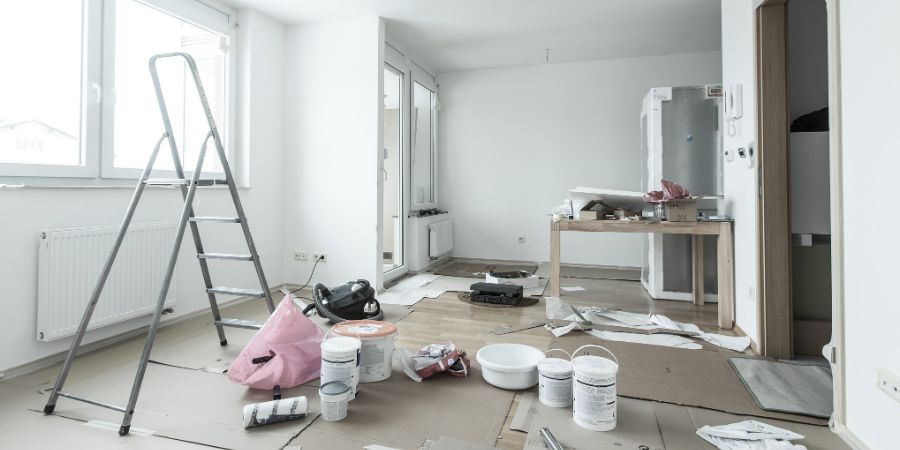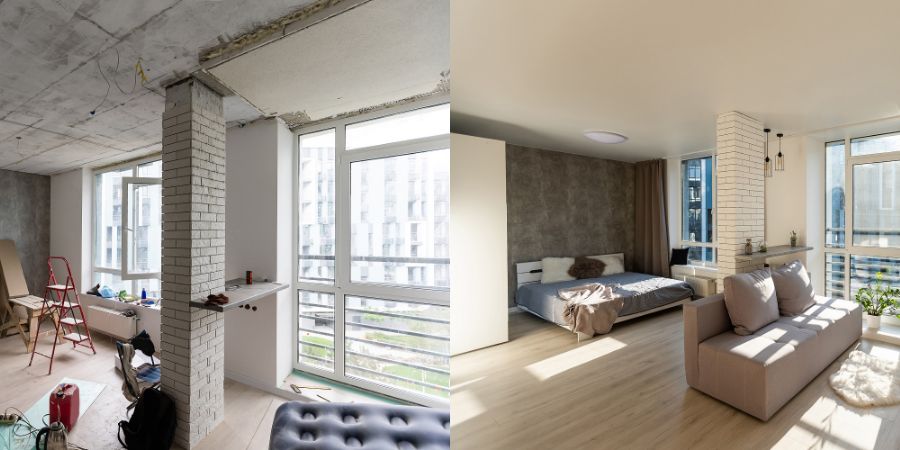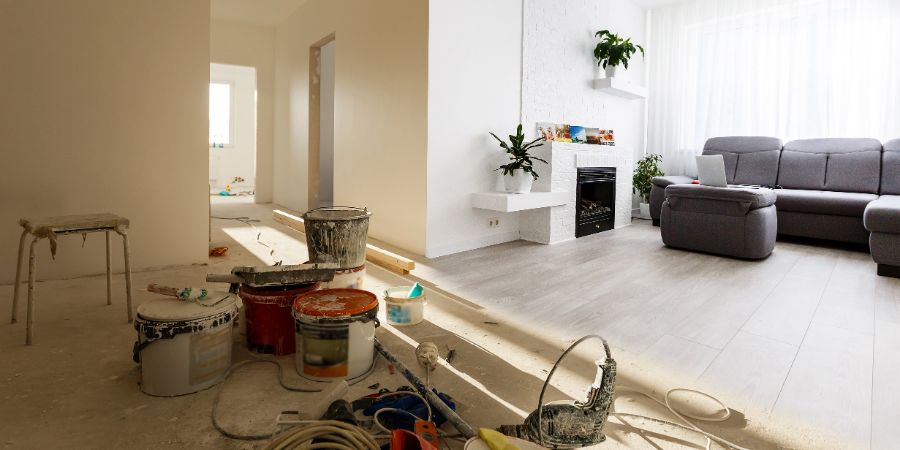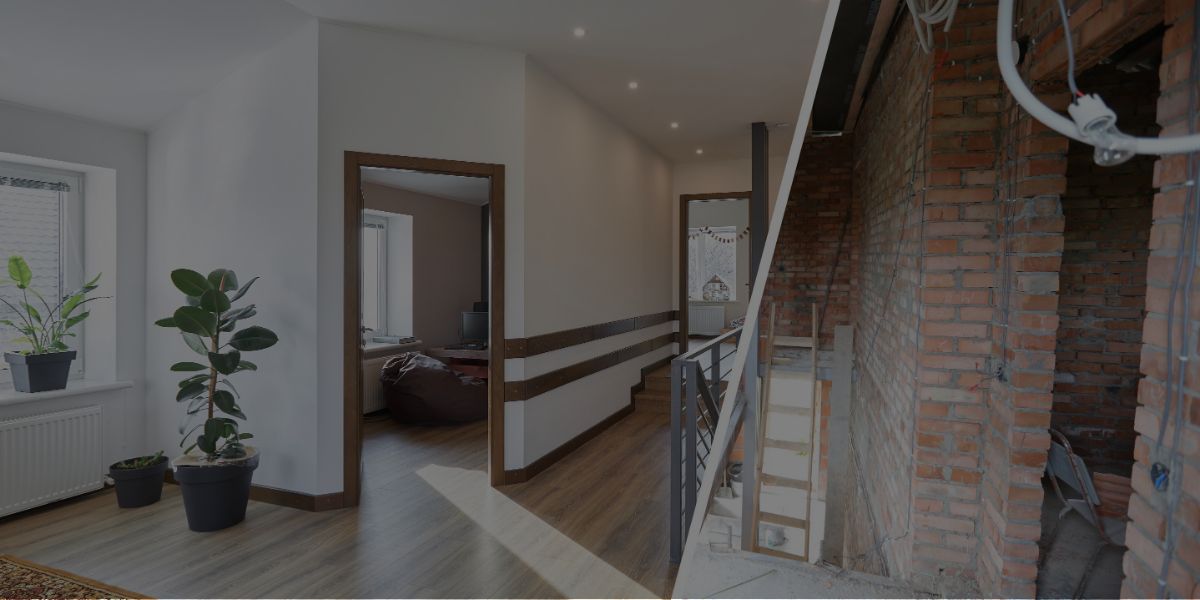Imagine: you’re a professional designer and you suddenly get a distressed call from one of your clients. They’ve just started the remodel you’re working with them on, but they’re not sure what to do – because they’re living in the house while it’s being renovated! As the professional, you know that living through a home renovation can be a difficult time for your clients.
Not only are they dealing with all of the noise and chaos that comes with a renovation; they may also have to live in the same space as all of the construction workers. But don’t worry, there’s a way you can come to their rescue!
By suggesting any (or all) of these 25 tips, you can help them make the process MUCH easier and less stressful!
So, let’s take a look at what they are, shall we?

Living Through a Home Renovation: 25 Tips To Give Your Design Clients
Life can be pretty tricky when your clients are living in their home during a remodel. But with the right tips, it doesn’t have to be! Here are 25 tips that you, as their professional designer, can offer them to help make things easier…
Not yet a certified, professional designer – but want to be? Discover how YOU can get trained and internationally-certified in as little as 3 short months with the help of QC Design School’s self-paced, online courses!
1. Have a plan in place to clean up after each day’s work is done.
Living with dust and debris can definitely be a problem! After all, the last thing your clients want to do at the end of the day is to have to clean up after all of the construction workers. So, help them plan for what needs to be done – and how it will get done.
For example, you can consider having the contractor sweep up each day. Alternately, you can suggest that your client rents a vacuum cleaner to help clean up messes. From there, the vacuuming can either be done by the contractor at the end of the day, or – if they’re up for it – your client can do this themselves.
2. Make sure all of the furniture is securely covered to protect it from damage.
This may include furniture wrap or plastic sheeting. This tip is essential when it comes to protecting your client’s furniture from damage caused by sanding, sawdust, and paint splatters.
Want to go above and beyond with this tip? You can also refer your clients to this helpful article on the topic, courtesy of Go Mini’s!
3. Create a designated “construction zone” that is off-limits to the client (and their family) while living through the home renovation process.
The purpose of this particular tip is to help your client feel secure while they’re living in the house. Plus, this will ensure that they don’t accidentally come into contact with any hazardous materials or construction tools.
A designated “construction zone” could be a living room, an unused bedroom, or even a hallway. Whatever the choice may be, it’s important to make sure that your client (and their family) are not in this area when construction is underway. By creating a designated construction zone, you can help to keep them and their loved ones safe while they’re living in the home during the remodel.
4. Take advantage of technology and tools to help out during the home renovation.
For example, you can use apps like Houzz or Pinterest to help your clients visualize their remodel as it is being completed. These apps can help them understand what the finished space will look like by providing easy-to-follow instructions, guided tours, and 3D renders.
Additionally, you can also suggest tools like virtual interior design software or home building calculators. These resources will allow you to more easily measure and plan for what the finished space will look like.
PRO TIP: Here are 8 more awesome design software recommendations you (and your client) can make use of!
5. Make sure that your client has a clear plan of action in place for managing waste and debris.
Nothing can ruin a remodel more than having piles of debris scattered everywhere. To combat this, suggest that your clients have a designated area outside the home where they collect construction waste and debris. This will help to keep the construction zone clean and organized – making life easier for both you (and your client) in the long run!
Waste management is essential when it comes to living through a home renovation. So, help ensure your clients are prepared by discussing this tip with them beforehand.

6. Ensure that proper ventilation is in place while construction is underway.
Living through a home renovation can also mean living with dust, paint fumes, and other airborne pollutants. Obviously, this can make things difficult! After all, this is not only annoying to deal with – but bad for your client’s health.
So, to ensure that your clients are able to breathe easy during the remodel process, discuss ways in which you can improve ventilation throughout the home!
For example, consider installing exhaust fans or air purifiers in affected rooms to help keep the air clean throughout the duration of the remodel. Additionally, you can also suggest opening windows and doors when possible to let in fresh air.
Ultimately, by improving ventilation throughout their home, your clients will be able to rest easy knowing that their living environment is safe and healthy during a remodel.
7. Help your client find ways to sleep easy at night.
We mean this in the most literal sense! When living on site while renovating, it can be difficult to sleep soundly. The noise from construction tools, the frequent dust and debris accumulation, and other distractions can make it challenging for your client (and their family) to get some rest.
So, suggest ways in which they can improve their sleeping environment! This could mean suggesting that the client purchase a white noise machine or install blackout curtains in the bedroom. These modifications can help your client create a calming environment that is conducive for sleep – even amidst the chaos of a home renovation.
8. Maximize a calendar for the home renovation project.
A well-constructed calendar is a great way for your client to keep track of their progress on the remodel. Firstly, this make it easier for them to stay organized. And secondly, it also helps to give them (and you) a better understanding of what needs to be done – and when.
For example, if you create a timeline calendar that outlines each step of the remodeling process, it’ll be easier for your client to track their progress and stay on top of their tasks. Talk about a great way to ensure that their home renovation project is running smoothly, without any hiccups (or delays)!
By taking advantage of calendars, you can help make sure your client’s home renovation project is completed on time and within budget.
9. Find other places to store furniture, if covering it isn’t an option.
Let’s say that, for whatever reason, your client cannot cover up their furniture while construction is underway. In that case, suggest that they find alternative places to store them in order to prevent any damage from occurring.
Perhaps this means renting a storage unit. Alternately, this could mean asking family and friends to hold onto their furniture for them. Or, quite simply, it could be a matter of moving the furniture into a different room of the house.
Either way, helping your client find ways to properly store their furniture is crucial during a home renovation. After all, you don’t want their belongings to be unintentionally damaged – or worse, destroyed – during the remodeling process!
10. Remind your client that living through a home renovation means always being prepared for the unexpected.
Life during a home renovation can be unpredictable. Due to the nature of construction work, unexpected issues often arise. These issue then need to be addressed quickly in order to prevent any further damage or disruption.
So, remind your client that they should always expect the unexpected! This could mean having an emergency kit ready with basic supplies (such as a flashlight, dust mask, gloves, and hardhat)… Just in case!
Additionally, you can suggest that your client keep a list of the contacts of various contractors and handymen. This way, they know who to contact if they encounter any unexpected problems during the construction process.
Basically, your client should always be prepared for the unpredictable… And so should you! Only then can everyone be better equipped to handle any hiccups that may arise throughout the home renovation project.
11. Be particular about which season the home renovation takes place in.
Living inside a construction site can be especially uncomfortable when the weather is not on your side. No one wants to live in a house with a constant draft during winter, after all! So, suggest to your client that they consider when their home renovation should take place.
For example, if the project requires working with cement or other materials that need time to dry, maybe suggest that the construction occur during summertime (or in any season with dry weather). That way, the project won’t be delayed due to bad weather conditions.
At the end of the day, being particular about which season the renovation takes place in is a great way to ensure that everything goes as smoothly as possible… And your client can plan their home improvement project accordingly!

12. Re-purpose non-renovated areas for multiple functions.
Living through a home renovation can often lead your clients to feeling cramped and overwhelmed. In order to prevent this, you can suggest that your client use non-renovated areas in their house for multiple functions.
For instance, instead of having just one living room, maybe have two or three smaller rooms that serve different purposes. This could be anything from a home office to a place for the kids to hang out.
Ultimately, by re-purposing non-renovated areas of the house, your client can make the most out of their limited space – and feel more comfortable during the remodeling process.
13. If possible, get to know the people working on the house.
It’s important for your client to have a good rapport with the people who are working on their house. After all, these contractors and workers will be in and out of their home for an extended period of time. So, it makes sense that they should feel comfortable in their presence!
Therefore, suggest to your client that they take some time to get to know the people who are working on their home. This could be anything from a quick chat or simply introducing themselves.
Getting to know these workers can help your client feel more at ease while living through a home renovation – and it also allows them to make sure that the construction process is going smoothly!
14. Reclaim the livable areas of the home by decluttering unnecessary items.
It’s easy for a home to get cluttered during a renovation – especially when there is limited living space. So, suggest to your client that they take some time out of their day to declutter the livable areas of their home.
This could be anything from getting rid of old furniture and clothes, or donating unused items to charity. Whatever the case, reclaiming these areas can help to make living through a home renovation much easier and more organized.
Ultimately, this will give your client some peace of mind during such a hectic time – which is invaluable!
PRO TIP: Learn how to successfully declutter all of your client’s storage spaces!
15. Consider landscaping options that won’t be hindered by construction.
If your client’s home renovation involves external work, you may want to suggest that they think about landscaping options that won’t be hindered by construction.
For instance, instead of planting a tree in the middle of the backyard, suggest that they opt for smaller plants and shrubs along the edges. This will enable them to enjoy their outdoor space without worrying about any land being destroyed or plants being uprooted.
In the end, this is a great way for your clients to spruce up their yard – without the fear of any potential construction-related damage!
Interested in adding landscape design to your professional skill set? Become a globally-certified International Landscape Design Professional (ILDP) in as little as 12 short weeks by taking QC Design School’s self-paced, online Landscape Design Course!
16. Use disposable plates and cups during the duration of the home renovation.
To make life easier while living through a home renovation, suggest to your clients that they use disposable plates and cups. This will cut down on the amount of dishes that need to be washed. Not to mention, it’s also easier than having to walk back and forth from the kitchen every time they want a drink or snack!
Plus, by using disposables, they can help prevent any construction-related messes from getting on their regular dishes. Overall, this is a great way for your clients to save time and energy during the remodeling process – without having to put up with any extra mess.
For added convenience, make sure that your clients purchase eco-friendly disposables. This way, they don’t have to worry about any negative environmental impacts!
17. Allot weekly time where there will be no renovating work.
As we’ve mentioned a few times by now, living through a home renovation can be extremely disruptive – and tiring! Therefore, suggest to your clients that they allot one day each week where there will be no renovating work.
This gives your client the opportunity to relax and enjoy their home without any construction-related noise or mess. Plus, it’s also a great way for them to take a break from the constant disruption of construction workers coming in and out.
Ultimately, this will help keep them (and their sanity!) in check while living through a home renovation. Sure, it might seem like a small gesture – but it can make all the difference in the long run!

18. Cut down on the time spent shopping.
Shopping plays a big part in the home renovation process. After all, your client needs to purchase all the materials and items for their remodel. But shopping can be time-consuming, especially when living on site during a remodel.
As a result, your client might find themselves spending a lot of unnecessary time – and unnecessary money – shopping for their items because the pressure of living through the renovation causes them to make rushed decisions.
To save your client both time and money, suggest that they take some time to plan. For example, maybe it’d be in their best interest to purchase all their materials and items from the same store. Another suggestion might be for them to purchase items online to save both time and energy.
In the end, help your client be as efficient as possible when it comes to shopping for their remodel – without having to sacrifice quality and convenience.
Where do the professionals tend to shop for their project needs? Here are 16 resources you can pass along to your clients for the best products and supplies!
19. Invest in a camping stove and microwave.
To save your clients the hassle of driving back and forth to the store whenever they want a hot meal, suggest that they invest in a camping stove and microwave instead. This way, they can quickly heat up their food without having to worry about any construction-related messes – or dangerous fumes!
Plus, by investing in a camping stove and microwave, your clients will also save money. After all, they won’t have to rely on take-out or delivery meals as much anymore.
Overall, this is a great little trick to make life easier while living through a home renovation!
20. Make sure your clients are aware of potential health hazards.
Earlier, we discussed the importance of proper air filtration during a home renovation. However, your clients should also be aware of other potential health hazards that come with remodeling. Living through a home renovation can be dangerous at times – and so this is something that your clients need to be aware of before they start the process!
For example, you should:
- Suggest to your clients that they always wear safety goggles, gloves, and masks whenever they’re dealing with hazardous materials (e.g., lead paint);
- Advise them to always keep the windows open and use fans to ventilate the area;
- Remind them to be aware of any potential fire hazards (e.g., using extension cords, smoking materials, etc.);
- Ensure that they keep children and pets out of the work zone at all times;
- Recommend that they check for any asbestos or lead-based paint in their home, as these can both cause serious health problems if not handled correctly.
21. Have a plan in place for babysitting and/or pet care.
If your client has children or pets at home, it’s important that they have a plan in place for babysitting and/or pet care during the renovation process. This will ensure that the kids (and pets!) are safe and out of harm’s way when construction workers are present. Plus, it’ll also put your clients’ mind at ease, knowing that their little ones are in good hands.
So, you can always suggest to your clients that they either hire a babysitter or pet sitter, or have friends/family members come over to help out. This way, their kids and pets can stay safe while they take care of all the remodeling work that needs to be done.
By having a plan in place for babysitting and/or pet care, your clients can rest assured that their little ones are safe and taken care of – even during a home renovation! And that’s always a great thing.
22. Create bathroom and kitchen strategies.
When living through a home renovation, it’s important that your clients create bathroom and kitchen strategies. This means they’ll need to figure out how they’re going to use the restroom and prepare meals when their bathrooms and/or kitchens are being remodeled.
For example, maybe your client can designate certain rooms in their house as “bathrooms” or “kitchens” during the remodel. Or, maybe they can invest in a portable toilet so that they always have access to a restroom during construction.
Additionally, your clients might want to invest in disposable plates and cutlery so that they don’t have to worry about washing dishes after every meal (as discussed in Tip #16). By creating bathroom and kitchen strategies, your clients can make life a bit easier while living through their home renovation!
23. Find extra ways to stay warm at night.
If your clients are living through a home renovation during the winter months, they’ll need to find extra ways to stay warm at night. This is especially true if their heating system isn’t working due to the remodel. So, you can suggest that they invest in a space heater or electric blanket for extra warmth and comfort.
Alternatively, your clients can also invest in a heated mattress pad so that they don’t have to worry about being cold while sleeping at night. This is especially helpful if their bedroom is the last room to be remodeled – as it’ll ensure that they stay cozy and warm throughout the entire process!

24. Set a realistic budget – and stick to it.
One of the most important tips to give your clients is to always set a realistic budget – and stick to it! This means they’ll need to create a budget that includes all necessary materials, supplies, and labor costs.
By setting a realistic budget, your clients can ensure that their home renovation project doesn’t spiral out of control in terms of cost. Plus, having a budget in place can also help to keep their stress levels down – which is always a plus when it comes to living through a home renovation!
25. Utilize the “staged” approach to remodeling.
By now, you know that living through a home renovation is no easy task, to say the least. As such, another option at your disposal is to suggest to your clients that they utilize the “staged” approach when it comes to remodeling their home.
This means that rather than tackling ALL the renovations at once – say, in one big chunk – they break it down into smaller stages. For instance, maybe they start by doing the kitchen first before tackling the bathrooms. Or perhaps they opt for a more multi-step approach where they do one room at a time – starting with the living room, then moving on to the dining area and so on.
The end result?
The entire remodel will be done quicker — and with less disruption. Plus, living on site while remodeling will become much more bearable with fewer tasks to handle at any given time!
Living On Site While Renovating: FAQs
Q: What should you do if living in your home during a remodel isn’t an option?
In some cases, living in your home during a remodel isn’t always an option – either due to the scope of work or the timeline of the project. In these cases, you can suggest that your clients rent a place temporarily while their home is being renovated. This will give them peace of mind knowing that no one is living in their house and that it’s clean and secure.
Q: What should you do if your client’s budget is too tight for a temporary rental?
If your client’s budget is too tight for a temporary rental, you can suggest that they stay with friends or family while their home is being renovated. This will cut down on the amount of money they need to spend – and it’ll also give them a much-needed break from the hustle and bustle of remodeling!
Q: What should be fixed first when renovating a home?
When it comes to renovating a home, there are several factors that you should consider when deciding which projects to take on first. Some of the most important ones include safety and functionality, as well as any structural or plumbing issues that may arise during the remodeling process.
By taking these into consideration, your clients can ensure that their home is safe and that their remodel is on track to fit their budget and timeline.
Q: What is the most expensive thing when renovating a house?
One of the most expensive items when renovating a house is usually labor. Depending on the scope of work and type of project, the cost of labor can range from a few hundred dollars to thousands – depending on who you hire to do the job! It’s important to factor this into your client’s budget so that they don’t end up overspending.
Another expensive item that often comes up during a home renovation is the cost of materials. Depending on what type of project and materials your clients need, these costs can add up quickly. So, it’s important to factor this into their budget as well!
Q: Does remodeling cause depression?
This is actually a very common question, so we felt it important to address. The honest answer is that yes, it can – but only if the renovation process is not properly managed.
When remodeling, it’s important to have realistic expectations and be prepared for any potential issues that may arise. Having a good plan in place and discussing any potential problems upfront can help reduce the chances of feeling overwhelmed or depressed during the home renovation.
This is why it’s so important that you give your clients the right advice and resources to help them through this difficult time. And if your clients are feeling overwhelmed or anxious during their remodel? Then it’s a good idea to refer them to mental health professionals who can provide them with the necessary support they need.

Conclusion
Living through a home renovation can be difficult for your clients, but it doesn’t have to be. By following these 25 tips, professional designers and homeowners alike can make living on site while renovating much more bearable – and even enjoyable! With the right advice and resources, you can help your clients create their dream home with minimal disruption.
Got any additional tips, questions, or comments?
Share them down below, as we always love to hear from you!
Thanks for reading… And happy renovating!


